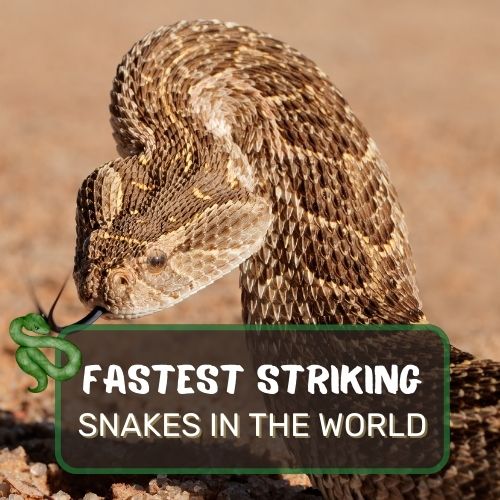
When you hear the question, “what is the fastest striking snake in the world?“, a myriad of images might come to mind.
Snakes, with their sleek bodies and hypnotic movements, have always fascinated us, but which among them holds the title for the swiftest strike?
This article delves deep into the world of these remarkable reptiles, comparing their speeds, venom potencies, and behaviors.
We’ve analyzed factors like habitat, striking behavior, and the potency of their venom to provide a comprehensive answer.
By journeying through this read, you’ll gain insights into the marvels of nature’s fastest strikers and develop a newfound respect for these incredible creatures.
Dive in to uncover the mysteries of the serpent world.
Table of Contents
- 1 Fastest striking snake in the world (The Puff adder)
- 2 The fascination with snakes and their striking speed
- 3 The importance of understanding snake behavior for safety
- 4 Understanding Snake Aggression
- 5 The Puffadder: The World’s Fastest Striker
- 6 The Black Mamba: Speed and Aggression Combined
- 6.1 Profile of the Black Mamba as one of the most aggressive and fastest snakes
- 6.2 Its habitat in South and East Africa
- 6.3 Speed capabilities: Moving up to 12 mph
- 6.4 Defensive behavior: Multiple bites in one attack, delivering a consistent amount of venom
- 6.5 The potency of its venom and the importance of antivenom
- 6.6 Its diet and preferred habitats
- 7 The Saw-Scaled Viper: A Deadly Aggressor
- 8 The Coastal Taipan: Australia’s Venomous Striker
- 9 The Bushmaster Snake: A Camouflaged Threat
- 10 Comparing the Most Aggressive Snakes
- 11 Safety Measures and Snake Encounters
- 12 Conclusion
- 13 FAQ: Most commonly asked questions
Fastest striking snake in the world (The Puff adder)
The Puff Adder (Bitis arietans) is renowned for its astonishingly rapid strike, which can be launched in a mere fraction of a second. Studies suggest that its strike speed can reach around 2.7 meters per second. What makes the Puff Adder’s strike particularly impressive is the combination of its muscular build and specialized skeletal structure. This allows it to coil tightly and then explosively uncoil, propelling its head forward with incredible speed. While other snakes might have faster overall movement, the Puff Adder’s strike is optimized for ambush, making it one of the fastest, if not the fastest, striking snakes in the world.
The fascination with snakes and their striking speed
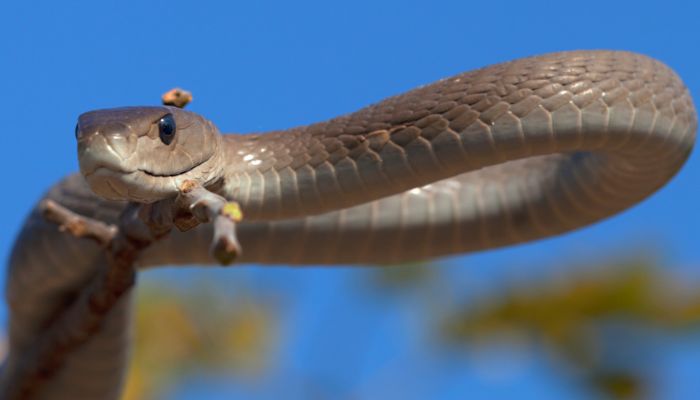
When you think of a snake, what’s the first thing that comes to mind? For many, it’s the mesmerizing, almost hypnotic way they move. But there’s another aspect of these reptiles that’s equally captivating: their striking speed.
Imagine being in the wild and witnessing a snake lunge at its prey. It’s a blink-and-you-miss-it moment. The Black Mamba, for instance, is not just one of the most venomous snakes but also one of the fastest strikers in the world.
It can move at speeds of up to 12 mph! That’s faster than most of us can run.
Now, let’s take a moment to appreciate this. The Black Mamba’s speed is not just about raw velocity. It’s a culmination of evolution, muscle coordination, and perfect timing. When it strikes, it’s a masterclass in precision.
And this isn’t just about hunting. Speed is also a defense mechanism. A rapid strike can deter potential threats, ensuring the snake’s survival.
The importance of understanding snake behavior for safety
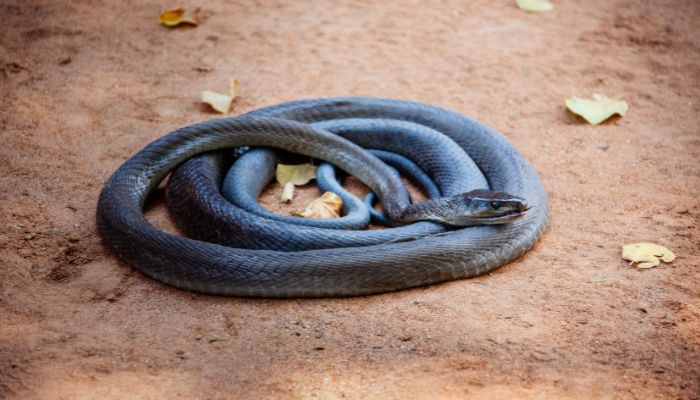
Understanding the behavior of snakes, especially their striking speed, is not just a matter of fascination. It’s crucial for safety.
Every year, there are numerous reports of snakebite incidents, many of which result from a lack of understanding or underestimating these creatures.
Take the Saw-Scaled Viper as an example. While it might not be as famous as the Black Mamba, it’s responsible for more human deaths than the combined deaths from all other snake species.
Its aggressive nature, combined with its ability to camouflage and frequent encounters with humans, makes it particularly dangerous.
Knowing its behavior, its striking speed, and the signs that it might be about to strike can be the difference between a close call and a fatal encounter.
But it’s not just about the venomous snakes. Even non-venomous snakes can strike rapidly when threatened.
Understanding this behavior is essential for anyone who spends time in nature, whether you’re hiking, camping, or just enjoying a day in the park. It’s always better to admire these magnificent creatures from a safe distance.
Understanding Snake Aggression
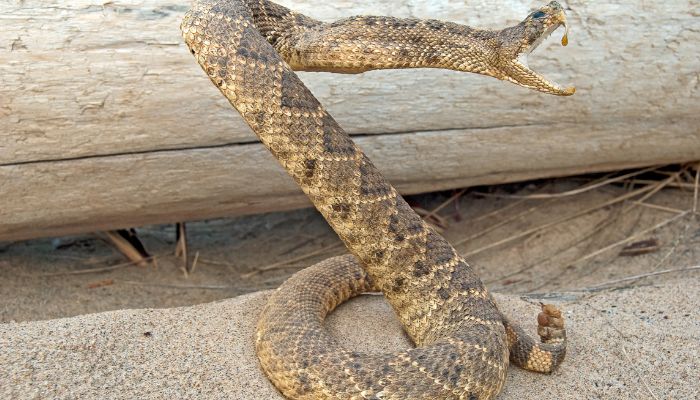
When it comes to snakes, there’s a lot of fear, and much of it stems from misunderstandings and myths.
The way snakes are portrayed in movies, stories, and sometimes even in educational content can lead to misconceptions about their behavior. Let’s dive deeper into understanding snake aggression and debunk some common myths.
Debunking myths: Snakes don’t attack unprovoked
One of the most widespread myths is that snakes are always on the offensive, ready to strike at any moment. However, this couldn’t be further from the truth. Snakes, like most animals, prefer to avoid confrontation.
They don’t see humans as prey, and they certainly don’t attack without reason. Most snake bites occur when the snake feels threatened or cornered.
For instance, stepping on a snake or accidentally cornering it might trigger a defensive strike. It’s their way of saying, “Back off!” rather than, “I’m going to eat you!”
Factors that can make a snake more aggressive: shedding skin and after a large meal
Understanding the factors that can make a snake more aggressive is crucial for safety. One such factor is the shedding process. When a snake is shedding its skin, the scales over its eyes become clouded.
This temporary blindness can make them feel more vulnerable, leading to increased aggression if they sense any movement or potential threat nearby.
Another factor is after they’ve had a large meal. A snake with a full belly is slower, making it harder for them to escape potential threats quickly. In such situations, they might become more defensive and quicker to strike if they sense danger.
In essence, understanding snake behavior and the factors that influence their aggression can help in preventing unwanted encounters.
It’s always essential to give snakes their space and be aware of your surroundings, especially in areas where these remarkable reptiles are common.
The Puffadder: The World’s Fastest Striker
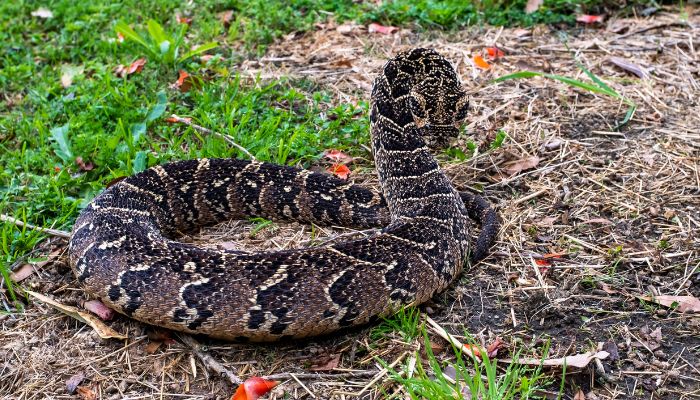
When discussing the fastest striking snakes, one name that often gets overshadowed by the more infamous Black Mamba or the Rattlesnake is the Puff Adder.
Yet, in terms of sheer striking speed, the Puff Adder stands tall, holding its own against the world’s most renowned reptiles. Let’s delve into the fascinating world of this lightning-fast striker.
Introduction to the Puff Adder
The Puff Adder (Bitis arietans) is one of Africa’s most widespread and venomous snakes. With its distinctive thick body, broad head, and beautifully patterned skin, it’s a snake that commands respect.
Its name is derived from its threat display, where it inflates and “puffs” itself up when feeling threatened.
How fast is the Puff Adder Strike?
The Puff Adder’s strike is nothing short of astonishing. In a fraction of a second, it can launch its strike, sinking its fangs into its prey or perceived threat.
Some studies suggest that its strike speed can rival even that of the notorious Rattlesnake, making it one of the fastest, if not the fastest, striking snakes in the world.
Studies suggest that its strike speed can reach around 2.7 meters per second.
Its movement speed is not that fast
While the Puff Adder’s strike is lightning fast, its general movement is more deliberate and slow-paced. It’s an ambush predator, relying more on its camouflage and patience than chasing down prey.
When it does move, it often uses a rectilinear motion, moving in a straight line, which is typical of many heavy-bodied snakes.
Its hunting behavior
The Puff Adder is a master of ambush. It relies on its cryptic coloration to blend seamlessly into its surroundings.
Once it finds a suitable spot, it can lie in wait for hours or even days, patiently waiting for an unsuspecting prey to come within striking distance.
When the moment is right, it launches its rapid strike, injecting its potent venom and then waiting for the venom to take effect before consuming its prey.
How potent is its venom?
The venom of the Puff Adder is a lethal cocktail of enzymes and proteins. It’s cytotoxic, meaning it destroys cells, often leading to severe tissue damage around the bite area.
The venom can cause pain, swelling, and in severe cases, necrosis. Systemic symptoms can include nausea, vomiting, and even respiratory distress.
While antivenom is available, a bite from a Puff Adder is always a medical emergency.
It’s worth noting that the Puff Adder is responsible for causing the most snakebite fatalities in Africa, primarily due to its widespread distribution and potent venom.
What is its preferred habitat?
The Puff Adder is highly adaptable and can be found in a variety of habitats across Africa. From grasslands, savannahs, to forest edges, and even semi-arid regions, this snake is not picky about its home.
Its adaptability is one of the reasons it’s so widespread. However, it does have a preference for areas with good cover, which aids its ambush hunting style.
In conclusion, the Puff Adder is a remarkable snake that deserves recognition not just for its striking speed but also for its adaptability, potent venom, and significant role in the ecosystems of Africa.
Understanding and respecting this snake is crucial for both our safety and the conservation of this incredible species.
The Black Mamba: Speed and Aggression Combined
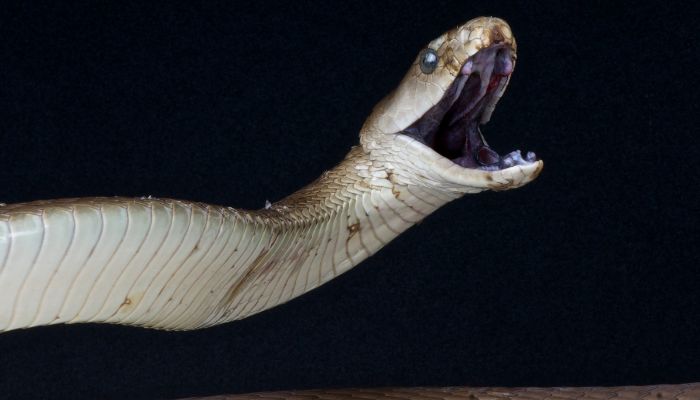
The world of snakes is filled with fascinating species, each with its unique set of characteristics. But when it comes to a combination of speed, aggression, and sheer awe, the Black Mamba stands in a league of its own.
Let’s dive into the captivating world of this African serpent.
Profile of the Black Mamba as one of the most aggressive and fastest snakes
The Black Mamba (Dendroaspis polylepis) is often regarded with a mix of respect and fear. And for a good reason. This snake is not only one of the fastest on the planet but also one of the most aggressive when threatened.
Its slender body, which can reach lengths of up to 14 feet, is built for speed.
Its name, interestingly, doesn’t come from its body color, which is usually a shade of grey, but from the inky black interior of its mouth, which it displays when threatened.
Its habitat in South and East Africa
Native to the terrains of South and East Africa, the Black Mamba can be found in a variety of habitats, from savannahs, woodlands, rocky slopes, to dense forests.
It’s a snake that has adapted well to its environment, making the most of the African landscape.
Speed capabilities: Moving up to 12 mph
One of the most defining characteristics of the Black Mamba is its incredible speed. Capable of moving at speeds of up to 12 mph, it’s faster than most humans can sprint. This speed is not just for hunting but also for escaping threats.
When a Black Mamba feels threatened, it can swiftly slither away, often choosing flight over fight.
Defensive behavior: Multiple bites in one attack, delivering a consistent amount of venom
However, when cornered or provoked, the Black Mamba’s defensive behavior is a sight to behold. It doesn’t just strike once. It can deliver multiple rapid bites, ensuring that its attacker gets a lethal dose of its potent venom.
This behavior underscores the importance of giving these snakes a wide berth and respecting their space.
The potency of its venom and the importance of antivenom
The venom of the Black Mamba is a deadly concoction of neurotoxins. A single bite, if left untreated, can be fatal to humans.
The venom affects the nervous system, leading to symptoms like blurred vision, difficulty in breathing, and eventually paralysis.
The rapid onset of symptoms highlights the importance of immediate medical attention and the administration of antivenom. In regions where the Black Mamba is prevalent, antivenom stocks are crucial in saving lives.
Its diet and preferred habitats
The Black Mamba, being an apex predator in its habitat, primarily feeds on birds and small mammals. Its incredible speed aids in hunting, allowing it to catch even the most agile of prey.
As for its preferred habitats, while it’s adaptable to various environments, it particularly favors tree canopies and rocky terrains, which offer both vantage points for hunting and hiding spots from potential threats.
In wrapping up, the Black Mamba is a testament to nature’s incredible design. Every aspect of this snake, from its speed to its venom, is a result of millions of years of evolution.
While it’s essential to approach this snake (and all snakes) with caution, it’s equally important to appreciate its role in maintaining the balance of its ecosystem.
The Saw-Scaled Viper: A Deadly Aggressor
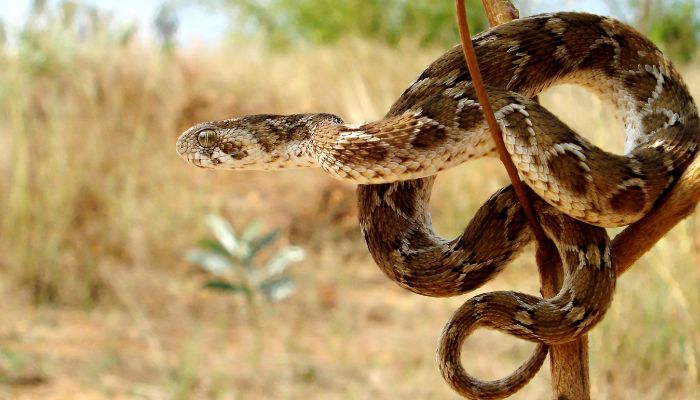
In the vast and varied world of snakes, certain species stand out not just for their unique characteristics but also for the impact they have on humans.
The Saw-Scaled Viper is one such snake. While it might not have the same global recognition as the Black Mamba or the King Cobra, its reputation in its native regions is one of caution and respect.
Introduction to the Saw-Scaled Viper’s aggressive nature
The Saw-Scaled Viper (Echis carinatus) gets its name from the unique sizzling sound it makes by rubbing its scales together, a warning sign of its agitation.
This relatively small snake, often not more than a foot long, packs a punch far beyond its size. When threatened, it’s quick to coil, hiss, and strike, displaying an aggression that’s earned it a formidable reputation.
Its responsibility for the most human deaths by snakebite
It’s a somber fact that the Saw-Scaled Viper is responsible for more human deaths due to snakebite than any other snake species.
This isn’t because its venom is the most potent (though it’s undoubtedly lethal), but because of a combination of factors: its widespread distribution, its aggressive nature, and the frequency of human encounters.
Its camouflage abilities and frequent encounters with humans
The Saw-Scaled Viper is a master of disguise. Its keeled scales and coloration allow it to blend seamlessly into its surroundings, making it almost invisible in sandy and rocky terrains.
This camouflage, while excellent for hunting prey, also leads to unintentional encounters with humans. Many bites occur when people inadvertently step on or near these vipers, triggering a defensive strike from the snake.
Habitat and behavior: nocturnal nature, hiding techniques
Primarily found in parts of Africa, the Middle East, and the Indian subcontinent, the Saw-Scaled Viper’s habitat ranges from arid deserts to grasslands and rocky regions.
Its behavior is primarily nocturnal, preferring the cooler temperatures of the night to hunt and stay active. During the day, it employs various hiding techniques, often burying itself in sand or seeking refuge under rocks.
This nocturnal nature, combined with its daytime hiding habits, further increases the chances of accidental encounters with humans during their active hours.
In conclusion, the Saw-Scaled Viper, with its aggressive nature and potent venom, serves as a stark reminder of the delicate balance between humans and nature.
While it’s essential to be aware and cautious, it’s equally important to respect and understand these creatures, ensuring that we can coexist without conflict.
The Coastal Taipan: Australia’s Venomous Striker
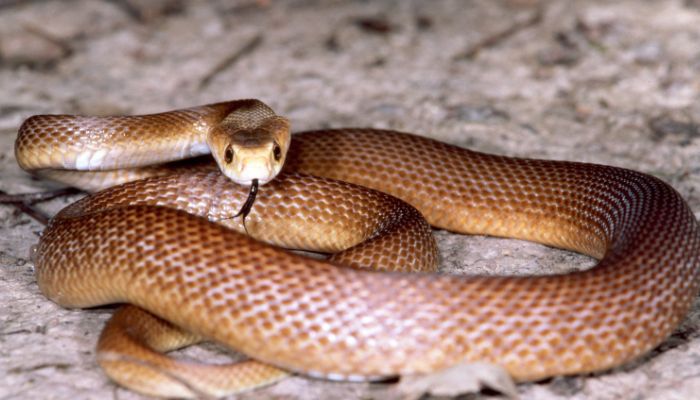
Australia, a land known for its unique wildlife and stunning landscapes, is also home to some of the world’s most venomous creatures. Among them stands the Coastal Taipan, a snake that commands respect and caution.
Let’s delve into the world of this formidable reptile.
Comparing the Coastal Taipan to the Black Mamba
When it comes to venomous snakes, the Black Mamba often steals the limelight. However, the Coastal Taipan, in many respects, is its Australian counterpart.
Both snakes are incredibly agile, have a potent venom, and can be highly aggressive when threatened.
While the Black Mamba is renowned for its speed, the Coastal Taipan is infamous for the potency of its venom.
Size-wise, the Coastal Taipan can grow up to 6.6 feet, making it Australia’s largest venomous snake, though it’s still shorter than the lengthy Black Mamba.
Its habitat in Australia and New Guinea
The Coastal Taipan is primarily found in the coastal regions of Northern and Eastern Australia, extending its range into parts of Papua New Guinea. Its preferred habitats include grasslands, coastal heaths, and cultivated fields.
Unlike some other venomous snakes, the Coastal Taipan often ventures into areas inhabited by humans, leading to occasional encounters.
Striking behavior: multiple bites per strike
One of the most terrifying aspects of the Coastal Taipan is its striking behavior.
When threatened or cornered, it doesn’t just deliver a single bite. Instead, it can strike multiple times in rapid succession, ensuring that its attacker or prey receives a lethal dose of its venom.
This behavior, combined with its agility, makes it a formidable predator and a snake to be approached with extreme caution.
Venom potency and its effects on victims
The venom of the Coastal Taipan is a potent mix of neurotoxins, myotoxins, and coagulants. A single bite can deliver enough venom to kill multiple adults.
Once envenomated, the victim can experience a range of symptoms, from headache, nausea, and vomiting to paralysis and internal bleeding.
Without prompt medical attention and the administration of antivenom, a bite from a Coastal Taipan can be fatal.
It’s worth noting that, thanks to the availability of antivenom and increased public awareness, fatalities from Coastal Taipan bites are rare nowadays.
In wrapping up, the Coastal Taipan, with its potent venom and aggressive behavior, is a testament to the diverse and sometimes dangerous wildlife of Australia.
While it’s essential to approach these creatures with caution, understanding their behavior and habitat can help in preventing unwanted encounters and ensuring the safety of both humans and snakes.
The Bushmaster Snake: A Camouflaged Threat
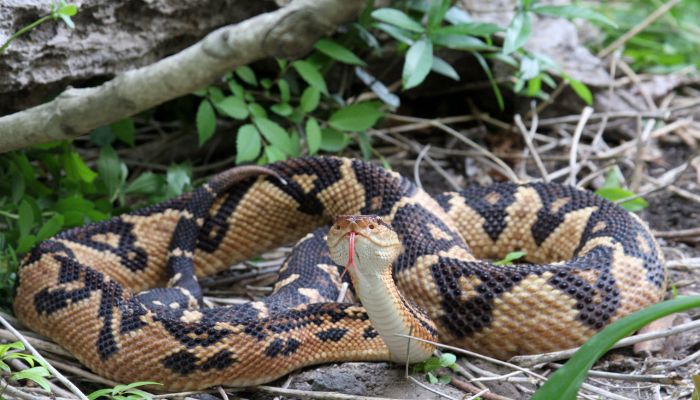
In the dense rainforests of Central and South America lurks a snake that, while not as globally renowned as some of its counterparts, is equally deserving of respect and caution.
Enter the Bushmaster, a snake that combines size, aggression, and stealth in one formidable package.
Introduction to the Bushmaster as one of the most aggressive snakes when threatened
The Bushmaster (Lachesis muta) is not a snake to be trifled with. While it generally prefers to avoid human interaction, when cornered or threatened, its response is swift and aggressive.
Its name, derived from its unique tail that resembles the brush of a broom, belies its dangerous nature. The Bushmaster is known to be one of the most aggressive New World snakes, especially when it feels its territory is being invaded.
Its status as the largest pit viper in the world
Size matters in the snake world, and the Bushmaster holds a significant title: it’s the largest pit viper globally. Adult Bushmasters can grow up to 10 feet in length, making them a force to be reckoned with.
Their size, combined with their potent venom, ensures they sit at the top of the food chain in their native habitats.
Habitat in Central and South America
The Bushmaster’s range spans the tropical rainforests of Central and South America. From Costa Rica to Brazil, this snake thrives in dense, humid environments.
The thick underbrush and leaf litter of the rainforest floor provide the perfect cover, allowing the Bushmaster to blend seamlessly into its surroundings.
Behavior: Camouflage, waiting for prey, and aggressive defense
The Bushmaster is an ambush predator par excellence. Using its exceptional camouflage abilities, it lies in wait, often for extended periods, for an unsuspecting prey to wander too close.
Once the prey is within striking distance, the Bushmaster delivers a rapid and deadly bite.
But it’s not just its hunting tactics that are noteworthy. The Bushmaster’s defensive behavior is equally impressive. When threatened, it doesn’t hesitate to stand its ground, coiling up and raising its head in a defensive posture.
If the threat continues to approach, the Bushmaster delivers a series of rapid strikes, ensuring that its message of “stay away” is loud and clear.
Comparing the Most Aggressive Snakes
When discussing the world’s most aggressive snakes, a few names consistently emerge at the forefront.

The Black Mamba, Saw-Scaled Viper, Coastal Taipan, and Bushmaster Snake each have their unique characteristics that make them both fascinating and formidable. Let’s take a moment to compare these reptilian marvels:
| Snake | Location | Speed | Venom Potency | Aggressive Behavior |
| Black Mamba | Africa | Up to 12 mph | Highly neurotoxic | Rapid strikes when threatened |
| Saw-Scaled Viper | Africa, Middle East, Indian subcontinent | Moderate | Cytotoxic | Quick to strike when provoked |
| Coastal Taipan | Australia, New Guinea | High | Extremely neurotoxic | Multiple rapid bites in succession |
| Bushmaster Snake | Central and South America | Moderate | Potent with hemotoxins and neurotoxins | Aggressive when cornered, defensive posture |
While each of these snakes has its unique traits, they all command respect and caution. Understanding their behavior and characteristics is crucial for anyone venturing into their habitats.
Safety Measures and Snake Encounters
The importance of understanding snake behavior for safety
Snakes, despite their sometimes fearsome reputation, are an essential part of our ecosystem. However, for those who live in or visit regions where venomous snakes are prevalent, understanding their behavior is paramount for safety.

Recognizing the signs of an agitated snake or knowing the habitats where they’re likely to be found can prevent unwanted encounters.
Tips for avoiding snake encounters and what to do if bitten
- Stay Aware: When hiking or walking in snake-prone areas, always watch where you step. Avoid tall grass and stick to well-trodden paths.
- Avoid Provocation: If you come across a snake, do not attempt to handle or provoke it. Give it a wide berth and allow it to move away.
- Wear Protective Clothing: In snake habitats, wear long pants and boots that cover the ankles.
- Know What to Do: If bitten, remain as calm and still as possible to slow the spread of venom. Do not attempt to suck out the venom or apply a tourniquet. Seek medical attention immediately.
The role of antivenom in treating snakebites
Antivenom is a life-saving treatment for venomous snakebites. It’s created by injecting small amounts of snake venom into animals, whose bodies produce antibodies. These antibodies are then harvested and used to create antivenom.
If administered in time, antivenom can neutralize the venom and prevent severe complications.
However, it’s essential to get the right antivenom specific to the snake species, underscoring the importance of identifying the snake or describing it to medical professionals.
In conclusion, while snakes can be dangerous, with the right knowledge and precautions, we can coexist safely with these incredible creatures.
Respect, awareness, and understanding are the keys to ensuring safety for both humans and snakes.

Conclusion
Nature, in all its vastness and diversity, never ceases to amaze. Among its myriad wonders, the world’s fastest striking snakes stand out as a testament to evolution’s brilliance.
These creatures, from the lightning-fast Black Mamba to the stealthy Bushmaster, showcase a blend of speed, precision, and power that few other animals can match.
However, with awe often comes fear, and it’s this fear that sometimes leads to misunderstandings and conflicts between humans and snakes.
It’s essential to remember that these snakes, as aggressive or venomous as they might be, play a crucial role in our ecosystem.
They control rodent populations, serve as prey for larger predators, and contribute to the delicate balance of nature.
As we venture into their habitats or they into ours, a mutual respect is paramount.
Understanding their behavior, recognizing their importance, and giving them the space they deserve ensures that we can coexist without conflict.
After all, every creature, no matter how fearsome, has its place in the tapestry of life.
FAQ: Most commonly asked questions
What snakes have the fastest strike?
The Black Mamba, Coastal Taipan, and Puff Adder are among the snakes known for their incredibly fast strikes. However, the exact speed can vary based on individual snakes and environmental factors.
What is the fastest striking snake in South Africa?
In South Africa, the Black Mamba is often recognized as one of the fastest striking snakes. The Puff Adder, while not as fast as the Black Mamba, is also known for its rapid strike and is responsible for more snakebite incidents in the region.
Can a human outrun a Black mamba?
While the Black Mamba can reach speeds of up to 12 mph, it’s unlikely to chase a human. Most humans can’t sustain such speeds over long distances, but over short bursts, a person might be able to outpace the snake. However, it’s essential to note that if you encounter a Black Mamba, it’s best to stand still and let it move away rather than trying to outrun it.
Do pythons strike fast?
Pythons, being constrictors, do have a fast strike, especially when capturing prey. They strike and quickly coil around their prey, constricting it. While their strike might not be as fast as some venomous snakes, it’s still swift and efficient.
How do you know if a snake will strike?
Snakes often give warning signs before striking. They might coil their body, flatten their head, hiss, or display other threat postures. It’s crucial to be observant and give snakes a wide berth, especially if they show signs of agitation.

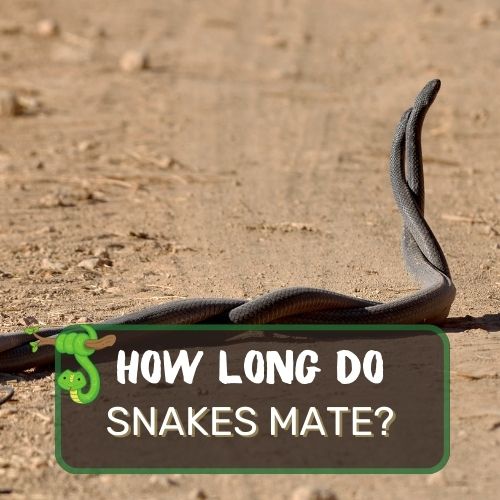

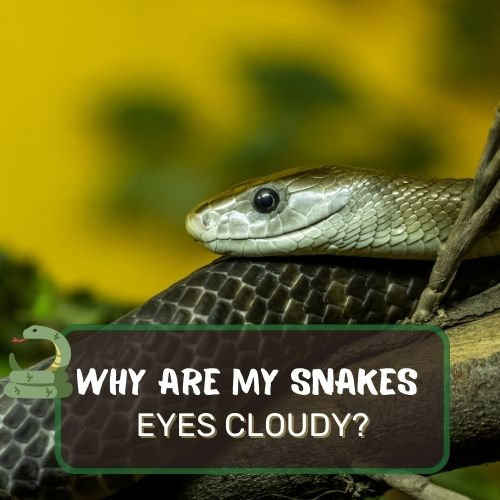
0 Comments